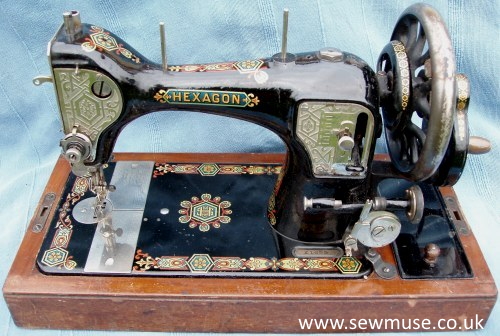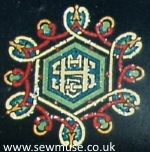The Hexagon Sewing Machine Company was established in 1917 by Franklin A. Park and Douglas Alexander in New York and an application for the company's Trade Mark was made in December of that year in the British West Indies.
Early Hexagon machines were manufactured in America, these machines had a Hexagonal pillar and arm. With the end of World War One production of the machine was moved to the Singer company's plant at Kilbowie, Scotland, the machine was cosmetically redesigned and the new machines were available by the Autumn of 1919.
It appears that the enterprise became a Limited Company in May 1919 and had offices at 69 Fleet Street London. The machines were sold in Great Britain and its colonies as well as France and Spain.
The company heavily promoted its hand machine and the same machine (but with different decals) was sold as the Harris No.5, The Referee (for Gamages), Collier No.8, Nelson's 61, The Berkeley, The Morton, and for Harrods Ltd as the Harrodia H6. From evidence gleened from serial numbers we know over 33,500 machines of this model were produced.
In May 1922 the company went into Voluntary Liquidation with James Everrett as the liquidator. However the company was re-constituted and by 1924 additional models had been introduced based on the Singer Company's existing range. There was a Medium Machine (Singer 127) and a Central Bobbin (Singer 15) these came in a variety of forms - hand, treadle or drophead treadle.
In 1924 the company again went into Voluntary Liquidation.

Hexagon: Serial No. X1655.
Produced for the Hexagon Sewing Machine Co. by the Singer Manufacturing Co. at Kilbowie in late 1919 or early 1920.
It is in excellent condition and although it was missing a slide plate we found those from a Singer 28 fit perfectly.
Note the Hexagonal decals and embossing to the bright work. The centre decal is HSM Co intertwined which was the company's registered Trade Mark.
In the 1930's the Singer Manufacturing Co. once again produced this model as the Singer 128-8 but with a grey crinkle finish.
Hexagon Model 127 Serial No. X65532.
This is a very unusual version of the Singer 127 made for the Hexagon Sewing Machine Co. Ltd around 1924 for sale in France. Note the "Fabrication Anglaise" on top of the arm.
It has all the features of the Model 127 including shuttle eject mechanism and bobbin winder mounted high on the shoulder.
A number of parts have Simanco stamped on them which is an abbreviation of Singer Manufacturing Co and confirms it was made by the company.
It carries the company's Trade Mark on the bed and the serial number is that of the Hexagon Sewing Machine Co. (rather than Singer) which prevents dating the machine accurately.
Most Singer 127's are treadle machines and it's likely this would have been but it does retain the mounting for a handcrank.
Although it's in reasonable condition there is some silvering to the decals and the slideplates have lost some of their Nickel Plating.
The rear inspection cover has SIMANCO 8300 on the reverse.
The faceplate is beautifully detailed.







